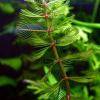Myriophyllum aquaticum
Scientific name: Myriophyllum aquaticum
Family: Haloragaceae
Maximum size reached under cultivation: 15 - 30 cm (5.91 - 11.81 inch)
014
Recommended pH range: 6 - 8
Recommended water hardness: 8 - 16°dGH (142.86 - 285.71ppm)
0°C 32°F30°C 86°F
Recommended temperature range: 23 - 28 °C (73.4 - 82.4°F)
Preferred propagation method: Cuttings
Native to: South America
Growth rate: Fast
Recommended substrate: Fine gravel
Lighting requirements: Bright
Ideal placement in tank: Background
Common Name
Parrot Feather
Origin
Myriophyllum aquaticum is native to South America, particularly in the Amazon River basin. Over time, it has spread to many other tropical and subtropical regions and is considered an invasive species in some areas due to its rapid growth and adaptability.
Growing Conditions
This plant can grow both submerged and emersed, although its feathery appearance is more pronounced when submerged. In open-topped aquariums or ponds, it may extend above the water surface and produce small white flowers, though this is rare due to the scarcity of male plants.
Myriophyllum aquaticum thrives in bright lighting and nutrient-rich conditions. A stable pH between 6.0 and 8.0 and water hardness of 8–16 dGH are ideal. It grows best at temperatures between 23–28°C (73.4–82.4°F). While not demanding, CO2 supplementation and liquid fertilization can improve growth and coloration.
Planting Area
With a potential height of 15–30cm (5.91–11.81in), Myriophyllum aquaticum is most suitable as a background plant in aquariums or as a decorative edge plant in ponds. In fry tanks, it serves as excellent cover and a safe hiding place for young fish. It should be planted in fine gravel substrate with adequate spacing between stems to allow proper light penetration.
Propagation
This plant is most reliably propagated by cuttings. Because nearly all cultivated specimens are female, sexual reproduction is rare. To propagate, take a healthy stem cutting, remove the lower leaves, and insert it carefully into the substrate without crushing the stem. In nature, the plant also spreads vegetatively by stem fragments, which break off and take root in new areas.
Difficulty
Myriophyllum aquaticum is considered easy to moderately difficult to grow. While it is tolerant of a range of water parameters, it is sensitive to mechanical damage—particularly from digging fish that may uproot the stems. Regular trimming helps maintain its form and prevents excessive overgrowth, especially in smaller tanks.
Short Description
Known for its elegant, feathery foliage, Myriophyllum aquaticum is a fast-growing aquatic plant that adds visual interest and natural shelter to planted aquariums and ponds. Its leaves display a soft green or bluish hue underwater and may transition to a greener shade above water. While it rarely flowers, when it does, it produces delicate white blooms.
Due to its rapid growth and ability to spread through cuttings or broken stems, this species can become invasive in outdoor settings. Proper disposal of trimmings is essential to prevent unwanted spread into local ecosystems.
Synonyms and Taxonomic Notes
Valid synonym: Myriophyllum brasiliense – historically used in older literature to refer to this species.
Note: Myriophyllum proserpinacoides is a distinct species and is sometimes confused with M. aquaticum due to similar appearance, but they differ in growth pattern and habitat preference.
Frequently Asked Questions (FAQ)
-
Can Myriophyllum aquaticum grow above water?
Yes, it can grow emersed in open-top aquariums or ponds. In this state, the plant may develop small white flowers, although flowering is rare due to the lack of male plants in most populations.
-
Is Parrot Feather suitable for outdoor ponds?
Yes, it’s commonly used in ponds due to its attractive appearance and fast growth. However, it can become invasive in certain climates, so always manage it responsibly and never dispose of cuttings in natural waterways.
-
Does this plant need CO2 supplementation?
CO2 supplementation is not required, but it can significantly enhance growth and improve foliage density and color.
-
How do I prevent the stems from breaking?
The stems are delicate and can be damaged by rough handling or digging fish. Plant in areas of the tank with low current and avoid keeping with species known for uprooting plants.
-
What’s the best way to propagate Parrot Feather?
Propagation is done through stem cuttings. Simply trim a healthy stem, remove the lower leaves, and replant it in the substrate. The new plant will root quickly and begin growing on its own.
-
Why are the leaves turning brown or falling off?
This may be due to insufficient light, nutrient deficiencies, or poor water conditions. Ensure bright lighting and regular fertilization to keep the plant healthy.

 Myriophyllum hippuroides
Myriophyllum hippuroides Myriophyllum spicatum
Myriophyllum spicatum Proserpinaca palustris
Proserpinaca palustris